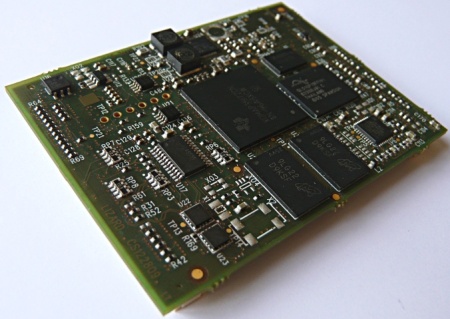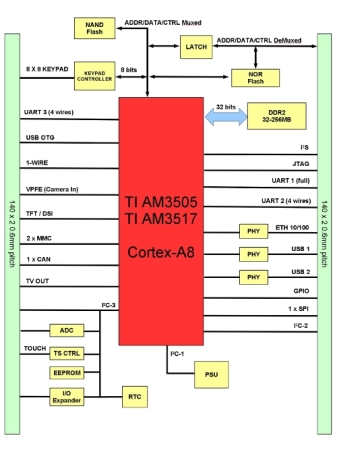Cortex-A8 COM offers extended temperature support
Nov 23, 2009 — by Eric Brown — from the LinuxDevices Archive — 1 viewsItalian embedded Linux firm Dave announced a CPU module based on Texas Instruments' ARM Cortex-A8-based AM3505 and AM3517 system-on-chips (SoCs). The 2.7 x 2/0-inch “Lizard” module offers connectivity including CAN, I2C, Ethernet, and serial I/O, provides extended temperature support, and is available with a Linux-ready evaluation board.
The Lizard supports applications including industrial control, home automation, point-of-service, and digital signage devices, says turnkey-system vendor Dave. The module builds upon the Texas Instruments (TI) Sitara AM3505 and AM3517 system-on-chips (SoCs), introduced last month. Unlike TI's earlier Cortex-A8-based OMAP35x SoCs, the Sitara SoCs have an industrial focus (perhaps it's no coincidence that just last week, TI joined the Open Source Automation Development Lab, an industry group working to improve Linux for use in industrial automation).
Unlike some of the earlier OMAP35x SoCs, the Sitara models lack video acceleration DSPs (digital signal processors), but the AM3517 is equipped with an OpenGL ES 2.0-based PowerVR SGX graphics accelerator. Otherwise, the two Sitara SoCs are identical. Clocked to 500MHz, they support DDR2 memory instead of the pricier LPDDR required by the earlier OMAP35x products.
The AM3505 and AM3517 both include a display subsystem offering picture-in-picture, color space conversion, rotation, and resizing support. They also add 10/100 Ethernet controllers, provide PHY (physical layer) functionality for their USB 2.0 on-the-go (OTG) interfaces, and include CAN controllers.

The Lizard
(Click to enlarge)
The module offers a video subsystem that supports displays with up to 24-bit video. The subsystem also offers touchscreen support, as well as video in and out, says Dave.
Peripheral support for the Lizard includes Ethernet, serial, USB Host and OTG, and 3.3V GPIO connectivity, says the company. Additional I/O includes interfaces for CAN, I2C, I2S, and SPI. The Lizard also offers extended operating temperature support, ranging from -40 to 185 deg. F.

Lizard block diagram
(Click to enlarge)
- Processor — TI AM3505/AM3517 ("Sitara") @ 500MHz
- Memory — Up to 256MB DDR2 RAM
- Flash — Up to 2GB NAND flash
- Flash expansion — 2 x SD/MMC connectors
- Display subsystem:
- Up to 24 bit, 74.25MHz pixel clock
- Video processing front-end (VPFE)
- TFT and TV out
- 16-bit video input port
- Touchscreen controller
- Networking — 1 x Fast Ethernet controller
- Other I/O interfaces:
- 2 x USB Host
- 1 x USB OTG
- 1 x "high-end" CAN controller
- 3 x UART
- 2 x I2C
- 1 x SPI
- 1 x I2S
- 3.3V GPIO "available"
- Other features:
- EEPROM
- RTC
- 8×8 keypad controller
- Zefeer board compatibility
- Dimensions — 2.76 x 1.97-inch (70 x 50mm)
Dave is offering a choice of LizardEVB-Lite or LizardEVB-High evaluation boards, both combining the Lizard module with the company's standard "Zefeer" baseboard design. Users can also plug Lizard modules into existing Zefeer boards, says the company.
The LizardEVB-Lite board is said to offer the following features:
- Display — LCD TFT and touchscreen support
- Networking — 10/100MBit Ethernet LAN w/PHY on RJ54
- USB — 3 x USB Host ports
- Serial — 3 x RS232 ports
- Other features:
- JTAG connector
- ADC
- I2S Audio
- Keypad
- GPIO
- ATX Power Connector
The LizardEVB-High version builds upon the Lite version with additional connectivity, says Dave. The High version is "a complete host board which provides all the Lizard's peripherals and much more, including an FPGA on-board," says the company.
The boards are said to be available with Linux or Windows CE board support packages (BSPs). The Linux BSP is based on Linux kernel 2.6.29, and includes the U-Boot bootloader and the Linux OS, both available with source code and binaries. Documentation is also provided, including manuals, user guides, and application notes, plus periodic updates, says the company.
Last December, Dave joined with German embedded Linux house Denx to release a co-developed computer module and evaluation board aimed at low-power industrial applications. The "Qong" module incorporates a Freescale i.MX31 SoC, and is available built into a Linux-ready "Qong EVB-Lite" evaluation board.
Availability
The Lizard Embedded Linux Kit Lite (LELK-L), which includes the Lizard-equipped LizardEVB-Lite "Zefeer" board, is available now for 500 Euros (about $748 U.S.) + VAT, says Dave. The Windows CE kit is said to be "coming soon." More information may be found here.
This article was originally published on LinuxDevices.com and has been donated to the open source community by QuinStreet Inc. Please visit LinuxToday.com for up-to-date news and articles about Linux and open source.